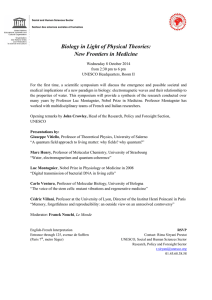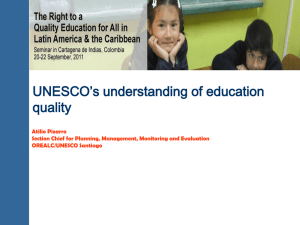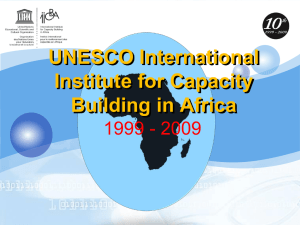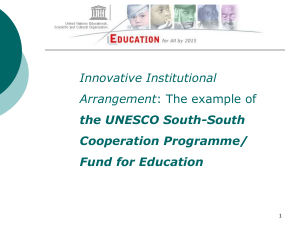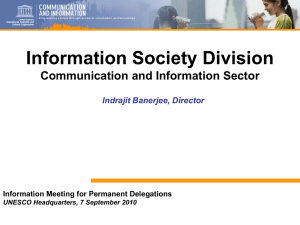测算创新:定义和指标
advertisement
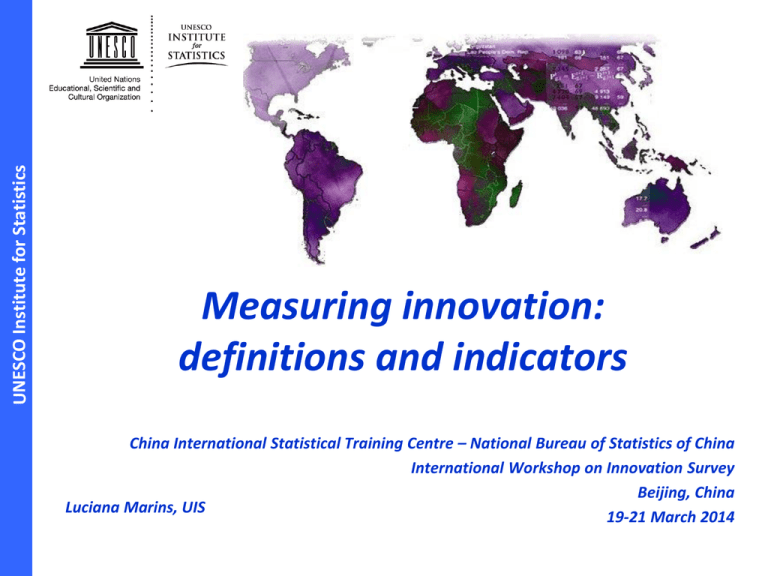
UNESCO Institute for Statistics Measuring innovation: definitions and indicators China International Statistical Training Centre – National Bureau of Statistics of China International Workshop on Innovation Survey Beijing, China Luciana Marins, UIS 19-21 March 2014 UNESCO Institute for Statistics 测算创新:定义和指标 联合国教科文组织统计研究所(UIS) 卢恰娜•马林斯 中国国际统计培训中心 中国国家统计局 创新统计国际培训班 中国,北京 2014年3月19日-21日 UNESCO Institute for Statistics Introduction to the Oslo Manual: Activities and factors influencing the development of innovations UNESCO Institute for Statistics 对《奥斯陆手册》的介绍: 影响创新发展的活动和因素 UNESCO Institute for Statistics (recap) Four types of innovation: Product; Process; Marketing; Organisational. UNESCO Institute for Statistics (扼要概述) 四类创新: 产品; 工艺; 市场营销; 组织方面。 UNESCO Institute for Statistics Innovation activities (1) Innovation activities: all scientific, technological, organisational, financial and commercial steps which (intended to) lead to the implementation of innovations; Some innovation activities are themselves innovative, others are not novel but necessary; R&D not directly related to the development of a specific innovation. UNESCO Institute for Statistics 创新活动(1) 创新活动:所有导致了(或试图导致)创新实现 的科学、技术、组织、金融和商业步骤。 一些创新活动本身就具有创新性,其它的虽不新 颖却是必要的; 研发(R&D)与某项特定创新的发展并不直接相 关。 UNESCO Institute for Statistics Innovation activities (2) For product and process innovations: Intramural (in-house) R&D; Acquisition of (extramural) R&D; Acquisition of other external knowledge; Acquisition of machinery, equipment and other capital goods; Other preparations for product and process innovations; Market preparations for product innovations; Training. UNESCO Institute for Statistics 创新统计(2) 产品和工艺创新: 内部的R&D; 获取(外部的)R&D; 获取其它外部知识; 获取机器、设备和其它资本货物; 产品和工艺创新的其它准备; 产品创新的市场准备; 培训。 UNESCO Institute for Statistics Innovation activities (3) Preparations for marketing innovations: Activities related to the development and implementation of new marketing methods; It includes acquisition of other external knowledge and of machinery, equipment, and other capital goods and training; Expenditures for using these methods in daily business are NOT included. UNESCO Institute for Statistics 创新活动(3) 市场营销的准备: 与新型市场营销方式发展和实施相关的活动; 这包括获取其它外部知识和机器、设备和其它资本货 物和培训。 在日常事务中使用这些方法的开支不包括在其中。 UNESCO Institute for Statistics Innovation activities (4) Preparations for organisational innovations: Activities undertaken for the planning and implementation of new organisation methods; It includes acquisition of other external knowledge and of machinery, equipment, and other capital goods and training. UNESCO Institute for Statistics 创新活动(4) 组织创新的准备: 为计划和实施新的组织方法开展的活动; 包括获取其它外部知识、机器、设备和其它资本货物 和培训。 UNESCO Institute for Statistics Kinds of innovation activities Successful: resulted in the implementation of a new innovation (not necessarily commercially successful); Ongoing: work in progress, which has not yet resulted in the implementation of an innovation; Abandoned: before the implementation of an innovation. UNESCO Institute for Statistics 创新活动的种类 成功: 结果是 实现了 一项新的创新(不一定是商 业上的成功) 进行中的:在进行当中的工作,尚未导致一项创 新的最终实现; 中止的:在一项创新实现之前。 UNESCO Institute for Statistics Example - abandoned or ongoing innovation activities UNESCO Institute for Statistics 例子 – 中止的或正在进行中的创新 活动 Classifying firms by degree of innovativeness UNESCO Institute for Statistics Innovative firm: Innovation-active firm: Implemented an innovation; Not necessarily a commercial success; Innovators; Had innovation activities, including ongoing or abandoned; Regardless of implementation; Potentially innovative firm: Innovation efforts but no achieved results; Key element for innovation policy; (Annex). UNESCO Institute for Statistics 依据创新程度对公司进行分类 具有创新性的公司: 实施了一项创新; 不一定引致商业上的成功; 创新者; 创新活跃的公司: 曾经有过创新活动,包括正在进行中的或者放弃了的; 无论是否得到了实施; 潜在的创新性公司: 在创新上作出努力但没有成果; 创新政策的关键元素; (附件)。 UNESCO Institute for Statistics Example - Innovative & Innovationactive firms - Product innovators: Firms 1, 3 & 4; - Process innovators: Firms 2, 3 & 4; - Both product and process innovators: Firms 3 & 4; - Firms with abandoned or ongoing activities: Firms 4 & 5; - Firms with abandoned or ongoing activities only: Firm 5; - Product and process innovation-active firms: Firms 1, 2, 3, 4 & 5; - Product or process non-innovative firms: Firm 6. Innovation Firm 1 Product innovation X Process innovation Abandoned or ongoing activities Firm 2 X Firm 3 Firm 4 X X X X X Firm 5 X Firm 6 UNESCO Institute for Statistics 例子 – 具有创新性和创新活跃的公司 - 产品创新者: 公司1、3和4; - 工艺创新者: 公司2、3和4; - 同为产品和工艺创新者:公司3和4; - 有被放弃了的和正在进行创新活动的公司:公司4和5; - 仅有被放弃了的和正在进行创新活动的公司:公司5; - 对产品创新和工艺创新积极的公司:公司1、2、3、4和5; - 在产品和工艺上缺乏创新的公司:公司6。 创新 产品创新 工艺创新 被放弃了的和 有正在进行的 创新活动 Firm 1 Firm 2 X X Firm 3 Firm 4 X X X X X Firm 5 X Firm 6 UNESCO Institute for Statistics Example - innovation activities and expenditures (pdt/pcs innovations) (1) UNESCO Institute for Statistics 例子 – 创新活动和支出 (产品或工 艺创新)(1) UNESCO Institute for Statistics Example - innovation activities and expenditures (pdt/pcs innovations) (2) UNESCO Institute for Statistics 例子 – 创新活动和支出 (产品或工 艺创新)(2) UNESCO Institute for Statistics Factors influencing innovation Objectives: motives for innovating; Effects: observed outcomes of innovations; Impacts on firm performance; Time lag; Hampering factors: Reasons for not starting innovation activities at all; Factors that slow innovation activity or have a negative effect on expected results. UNESCO Institute for Statistics 创新的影响因素 目的:创新的动机。 影响:可以观测到的创新结果; 对公司业绩的影响; 时滞; 阻碍因素: 根本不启动创新活动的原因; 拖慢创新活动或对预期结果有负面影响的因素。 UNESCO Institute for Statistics Linkages Linkages: connections with other agents; Source, cost, level of interaction; Types of external linkages: Open information sources; Acquisition of knowledge and technology; Innovation co-operation. UNESCO Institute for Statistics 关联 关联:与其它机构的联系; 信息源、支出、互动的程度; 外部关联的类型: 开放的信息源; 获取 知识和技术; 协作 创新。 Sources for transfers of knowledge and technology Open information sources Sources for purchases of knowledge & technology Cooperation partners * * * * * * * * * * * * * * * * * * * * * * * * * * * * * * * UNESCO Institute for Statistics Internal sources within the enterprise: R&D / Production / Marketing / Distribution Other enterprises within the enterprise group * External market and commercial sources: Competitors Other enterprises in the industry Clients or customers Consultants / consultancy firms Suppliers Commercial laboratories Public sector sources: Universities and other higher education institutions Government / public research institutes Private non profit research institutes Specialised (semi) public innovation support services General information sources: Patent disclosures / Professional conferences, meetings, literature and journals / Fairs and exhibitions / Professional associations, trade unions / Other local associations / Informal contacts or networks / Standards or standardisation agencies / Public regulations * 可以购买的 知识和技术 资源 合作伙伴 * * * * * * * * * * * * * * * * * * * * * * * * * * * * * * * 开放的信息 资源 知识和技术转移的来源 UNESCO Institute for Statistics 企业内部资源: R&D / 生产 / 市场营销 / 分配 企业集团内的其它企业 * 外部市场和商业资源: 竞争对手 统一产业内的其他企业 客户或消费者 顾问 / 顾问公司 供应商 商业实验室 公共部门资源: 大学和其它高等教育机构 政府 / 公共研究机构 私人的非营利研究机构 专业的(半专业)公共创新支持服务 一般信息资源: 公开的专利 / 专业会议、文献和期刊 / 展会 / 专业协 会、工会 / 其它地方协会 / 非正式的接触或网络 / 标 准或标准化机构 / 公共法规 * UNESCO Institute for Statistics Example - co-operation (1) UNESCO Institute for Statistics 例子 – 合作(1) UNESCO Institute for Statistics Example - co-operation (2) Importance Location Partner Objective Partner UNESCO Institute for Statistics 例子 – 合作(2) 重要性 地点 合作伙伴 目标 合作伙伴 UNESCO Institute for Statistics Example - hampering factors (1) UNESCO Institute for Statistics 例子 – 阻碍因素(1) UNESCO Institute for Statistics Appropriability Ability of enterprises to appropriate gains from innovation activities. Formal methods: Patents, registration of design, trademarks, copyrights, confidentiality agreements, trade secrecy; Informal methods: secrecy that is not covered by legal agreements, complexity of product design, lead time advantage over competitors. UNESCO Institute for Statistics 专属权 企业从创新活动中获取收益的能力。 正式方法: 专利权、外观设计注册、商标、版权、保密协议、商 业秘密; 非正式方法: 在法定协议中不包括的秘密、产品设计的复杂性、较 之竞争对手的时间优势。 UNESCO Institute for Statistics Developing countries Developing countries 3rd ed. OM standards, adaptations; LA: the Bogota Manual (RICYT, 2001); UIS: Annex (A) to 3rd ed. OM; Innovation Surveys in Developing Countries. UNESCO Institute for Statistics 发展中国家 发展中国家 《奥斯陆手册》第三版标准、改编; 拉丁美洲:《波哥大手册》(南美洲科技指标网络 ,2001年); UIS:《奥斯陆手册》第三版,附录(A); 发展中国家创新调查。 UNESCO Institute for Statistics Adaptations Linkages: Agents + Types + Location; Innovation Activities: Hardware purchase and Software purchase (split); Industrial design and Engineering activities (split); Lease or rental of machinery, equipment and other capital goods; In-house software system development; Reverse engineering. UNESCO Institute for Statistics 适应性的变化 关联: 机构 + 类型 + 地点; 创新活动: 硬件购买和软件购买(分离的); 工业设计和工程活动(分离的); 租赁机器、设备和其它资本货物; 内部软件系统开发; 逆向工程。 UNESCO Institute for Statistics Basic innovation indicators: examples UNESCO Institute for Statistics 基本的创新指标: 例子 UNESCO Institute for Statistics Indicators Indicators: Statistics and data, often gathered through specialised surveys, are the building blocks from which indicators are constructed; An indicator can be defined as something that helps us understand where we are, where we are going and how far we are from a specific goal. Therefore it can be a sign, a number, a graphic; An indicator quantifies and simplifies phenomena and helps us understand complex realities. Source: International Institute for Sustainable Development / Adapted from Blankley, W. (2012). Providing and calculating innovation indicators. Cape Town, South Africa. ASTII/HSRC/UIS Workshop. (PowerPoint Presentation) UNESCO Institute for Statistics 指标 指标: 统计资料和数据 通常由专门的调查收集而来,是指标 构建的基本成分; 在定义一个指标时,可以认为它的作用是帮助我们认 识 我们在哪儿、我们正在去哪儿和我们距离一个特定 目标还有多远 。因此它可以是一个标志、一个数字、 一个图形; 一个指标可以 量化和简化 某种现象并帮助我们理解复 杂的现状。 Source: International Institute for Sustainable Development / Adapted from Blankley, W. (2012). Providing and calculating innovation indicators. Cape Town, South Africa. ASTII/HSRC/UIS Workshop. (PowerPoint Presentation) UNESCO Institute for Statistics Innovation indicators Types: Basic indicators; Composite indicators: combine answers to several questions in order to examine a number of policy-relevant factors and better capture the diversity of innovative firms. UNESCO Institute for Statistics 创新指标 类型: 基本指标; 综合指标: 结合回答几个问题,为的是检验一些列与 政策相关的指标和更好地捕捉创新性公司的多样性。 UNESCO Institute for Statistics Data collection and processing (1) Aspects to keep in mind, in particular for comparisons: Response rate, treatment of non-response, type of data, etc.; Observation period; Statistical unit; Size cut-off point & classes; Industrial coverage. UNESCO Institute for Statistics 数据收集和处理(1) 需要记住的几个方面,特别是做对比的时候: 反馈率、对于无反馈的处理、数据的类型,等等; 观察期; 统计单位; 大小分界点和级别; 产业覆盖的范围。 UNESCO Institute for Statistics Data collection and processing (2) Statistical unit: Enterprise 2 countries (HKG, TUN) Size cut-off point: 1 country (ETH) Enterprise group EMP10 6 Enterprise Establishment 4 countries (IDN, MYS, PSE, PHL) Turnover 5 5 1 country (CUB) Kind of activity unit Number of employees / Turnover 4 17 countries (AZE, BLR, CHN, COL, CRI, CUB, DOM, ECU, LSO, PAN, PRY, PER, SRB, UGA, UKR, URY, ZMB) Number of employees / Other 3 6 countries (AZE, ETH, MYS, UGA, URY, ZMB) 2 3 1 1 0 0 employee Source: 2012 UIS Innovation Metadata Collection Number of employees 3 countries (CHN, PSE, UKR) 2 countries (PAN, PER) 1 employee 1 12 countries (BLZ, HKG, COL, CRI, DOM, ECU, IDN, LSO, PRY, PHL, SRB, TUN) 5 employees Number of employees / Turnover / Other 10 employees 1 16 employees UNESCO Institute for Statistics 数据收集和处理(2) 统计单位: 企业 2 countries (HKG, TUN) 规模分界点: 1 country (ETH) Enterprise group 10名员工 6 Enterprise Establishment 4 countries (IDN, MYS, PSE, PHL) Turnover 5 5 1 country (CUB) Kind of activity unit Number of employees / Turnover 4 17 countries (AZE, BLR, CHN, COL, CRI, CUB, DOM, ECU, LSO, PAN, PRY, PER, SRB, UGA, UKR, URY, ZMB) Number of employees / Other 3 6 countries (AZE, ETH, MYS, UGA, URY, ZMB) 2 3 1 1 0 0 employee Source: 2012 UIS Innovation Metadata Collection Number of employees 3 countries (CHN, PSE, UKR) 2 countries (PAN, PER) 1 employee 1 12 countries (BLZ, HKG, COL, CRI, DOM, ECU, IDN, LSO, PRY, PHL, SRB, TUN) 5 employees Number of employees / Turnover / Other 10 employees 1 16 employees UNESCO Institute for Statistics Data collection and processing (3) Industrial coverage: (National industrial classification system); ISIC; NACE. ISIC Rev. 4 INDUSTRY 01-03 Agriculture forestry and fishing 05-09 Mining and quarrying 10-33 Manufacturing 35-39 Electricity, gas, steam, air conditioning and water supply; sewerage, waste management and remediation activities 41-43 Construction 45-82 Services of the business economy 84, 85 Public administration and defence; compulsory social security and education 86-88 Human health and social work activities 90-93 Arts, entertainment and recreation 94-99 Other service activities; activities of households as employers and of extraterritorial organisations and bodies UNESCO Institute for Statistics 数据收集和处理(3) 产业覆盖范围: (全国产业分类体系); 《国际标准行业分类法》;ISIC Rev. 4 《欧洲共同体内部经 济活动统计分类》。 INDUSTRY 01-03 Agriculture forestry and fishing 05-09 Mining and quarrying 10-33 Manufacturing 35-39 Electricity, gas, steam, air conditioning and water supply; sewerage, waste management and remediation activities 41-43 Construction 45-82 Services of the business economy 84, 85 Public administration and defence; compulsory social security and education 86-88 Human health and social work activities 90-93 Arts, entertainment and recreation 94-99 Other service activities; activities of households as employers and of extraterritorial organisations and bodies UNESCO Institute for Statistics Data collection and processing (4) More: Numerators; Denominators. UNESCO Institute for Statistics 数据收集和处理(4) 更多: 分子; 分母。 UNESCO Institute for Statistics Calculating innovation indicators (1) Product or process innovation: 1. 2. 3. 4. 5. 6. 7. % of firms that implemented product innovation (only) % of firms that implemented process innovation (only) % of firms that implemented product and process innovation % of firms that implemented product or process innovation (innovative firms) % of firms that implemented product or process innovation or had abandoned or ongoing innovation activities (innovationactive firms) % of firms that developed in-house product or process innovation % of firms that implemented new-to-market product innovation UNESCO Institute for Statistics 计算创新指标(1) 产品创新或工艺创新: 1. (仅)实行了产品创新的公司百分比 2. (仅)实行了工艺创新的公司百分比 3. 同时实行了产品和工艺创新的公司百分比 4. 实行了产品创新或工艺创新的公司(创新性公司)百分比 5. 实行了产品创新,或工艺创新,或有已经被放弃的创新活动, 或有正进行的创新活动的公司(创新活跃的公司)百分比 6. 开展了内部产品创新或工艺创新的公司百分比 7. 实施了新进入市场产品创新的公司百分比 UNESCO Institute for Statistics Calculating innovation indicators (2) Product or process innovation: 1. (N) = % of firms that implemented product innovation Number of firms that implemented product innovation (in each economic activity or size class) *100 (D) = Total number of firms (in each economic activity or size class) (N) = Number of Manufacturing firms that implemented product innovation (D) = Total number of Manufacturing firms *100 UNESCO Institute for Statistics 计算创新指标(2) 产品创新或工艺创新: 1. (N) = 实施了产品创新的公司百分比 实施了产品创新的公司数(在每一类经济活动或大小类别 当中) *100 (D) = 公司总数(在每一类经济活动或大小类别当中) (N) = 实施了产品创新的制造业公司数 *100 (D) = 制造业公司总数 UNESCO Institute for Statistics Calculating innovation indicators (3) Product or process innovation: Product innovation Process innovation 75 60 45 30 15 Brazil China Colombia Source: 2011 UIS Pilot Data Collection of Innovation Statistics Egypt Israel Malaysia Philippines Russian Federation South Africa Uruguay UNESCO Institute for Statistics 计算创新指标(3) 产品或工艺创新: Product innovation Process innovation 75 60 45 30 15 Brazil China Colombia Source: 2011 UIS Pilot Data Collection of Innovation Statistics Egypt Israel Malaysia Philippines Russian Federation South Africa Uruguay UNESCO Institute for Statistics Calculating innovation indicators (4) Product or process innovation: 4. (N) = % of firms that implemented product or process innovation (pdt/pcs innovative firms) Number of firms that implemented product or process innovation (in each economic activity or size class) *100 (D) = Total number of firms (in each economic activity or size class) (N) = Number of Manufacturing firms that implemented product or process innovation (D) = Total number of Manufacturing firms *100 UNESCO Institute for Statistics 计算创新指标(4) 产品或工艺创新: 4. (N) = 实施了产品或工艺创新的企业百分比(产品或工艺创新 的公司) 实施了产品或工艺创新的公司数量(在每一类经济活动或 大小类别当中) *100 (D) = 公司总数(在每一类经济活动或大小类别当中) (N) = 实施了产品或工艺创新的制造业公司数量 *100 (D) = 制造业公司总数 UNESCO Institute for Statistics Calculating innovation indicators (5) Product or process innovation: (pdt/pcs innovative firms = A + B - C) Manufacturing firms A. Product innovators C. (A ∩ B) B. Process innovators UNESCO Institute for Statistics 计算创新指标(5) 产品或工艺创新: (产品或工艺创新公司 = A + B – C) 制造业公司 A. 产品创新者 C. (A ∩ B) B. 工艺创新者 UNESCO Institute for Statistics Calculating innovation indicators (6) Product or process innovation: 5. (N) = % of firms that implemented product or process innovation or had abandoned or ongoing innovation activities (pdt/pcs innovation-active firms) Number of innovation-active firms (in each economic activity or size class) *100 (D) = Total number of firms (in each economic activity or size class) (N) = Number of innovation-active firms in Manufacturing *100 (D) = Total number of firms in Manufacturing UNESCO Institute for Statistics 计算创新指标(6) 产品或工艺创新: 5. 实施了产品或工艺创新的,或者有放弃了的或正在进行的创 新活动的公司百分比(产品或工艺创新活跃的公司) (N) = 创新活跃的公司数量(在每一类经济活动或大小类别当中) *100 (D) = 公司总数(在每一类经济活动或大小类别当中) (N) = 制造业公司中创新活跃的公司数量 *100 (D) = 制造业公司总数 UNESCO Institute for Statistics Calculating innovation indicators (7) Product or process innovation: (pdt/pcs innovation-active firms = E + F - G) Manufacturing firms E. Product or process innovators G. (E ∩ F) F. Firms with abandoned or ongoing activities for product and process innovation UNESCO Institute for Statistics 计算创新指标(7) 产品或工艺创新 (对产品或工艺创新积极的公司 = E + F – G) 制造业公司 E. 产品或工艺 创新者 G. (E ∩ F) F. 有放弃了的或 正在进行的 创新活动 的公司 UNESCO Institute for Statistics Calculating innovation indicators (8) Product or process innovation: (pdt/pcs innovation-active firms) Manufacturing firms H. Innovationactive firms for product and process innovation J. (H ∩ I) I. Organisational or marketing innovators UNESCO Institute for Statistics 计算创新指标(8) 产品或工艺创新: (对产品或工艺创新积极的公司) 制造业公司 H. 对产品或工 艺创新积极 的公司 J. (H ∩ I) I. 组织或市 场营销的 创新者 UNESCO Institute for Statistics Calculating innovation indicators (9) Marketing or organisational innovation: 1. % of firms that implemented marketing innovation 2. % of firms that implemented organisational innovation 3. % of firms that implemented marketing or organisational innovation UNESCO Institute for Statistics 计算创新指标(9) 市场营销或组织创新: 1. 实施了市场营销创新的公司百分比 2. 实施了组织创新的公司百分比 3. 实施了市场营销或组织创新的公司百分比 UNESCO Institute for Statistics Calculating innovation indicators (10) Marketing or organisational innovation: 3. % of firms that implemented marketing or organisational innovation Number of firms that implemented marketing or (N) = organisational innovation (in each economic activity or size class) *100 (D) = Total number of firms (in each economic activity or size class) (N) = Number of Large Manufacturing firms that implemented marketing or organisational innovation (D) = Total number of Large Manufacturing firms *100 UNESCO Institute for Statistics 计算创新指标(10) 市场营销或组织创新: 3. (N) = 实施了市场营销或组织创新的公司百分比 实施了市场营销或组织创新的公司数量(在每一类经济活 动或大小类别当中) *100 (D) = 公司总数(在每一类经济活动或大小类别当中) (N) = 实施了市场营销或组织创新的大型制造业公司数量 *100 (D) = 大型制造业公司总数 UNESCO Institute for Statistics Calculating innovation indicators (11) Inputs: 1. Total expenditures on innovation (as a % of total turnover) 2. Expenditure on innovation by type of expenditure (as a % of total expenditure on innovation) 3. % of firms that performed R&D 4. % of firms that performed R&D on a continuous basis UNESCO Institute for Statistics 计算创新指标(11) 投入: 1. 创新总支出(总营业额的百分比) 2. 按照支出类型区分的创新支出(创新总支出的百分比) 3. 开展R&D的公司百分比 4. 持续性开展R&D的公司百分比 UNESCO Institute for Statistics Calculating innovation indicators (12) Inputs: 3. (N) = % of firms that performed R&D Number of product or process innovation-active firms that performed R&D (in each economic activity or size class) (D) = Total number of product or process innovation-active firms (in each economic activity or size class) (N) = Number of product or process innovation-active firms in Services firms that performed R&D (D) = Total number of product or process innovation-active firms in Services *100 *100 UNESCO Institute for Statistics 计算创新指标(12) 投入: 3. (N) = 开展R&D的公司百分比 产品或工艺创新活跃的公司当中开展R&D的公司百分比 (在每一类经济活动或大小类别当中) (D) = 产品或工艺创新活跃的公司总数(在每一类经济活动或大 小类别当中) (N) = 在产品或工艺创新上活跃的服务业公司中,开展R&D的公 司数量 *100 *100 (D) = 服务业中产品或工艺创新的公司总数 Calculating innovation indicators (13) UNESCO Institute for Statistics Key policy-relevant characteristics: 1. 2. 3. 4. 5. 6. 7. % of firms that were active on international markets % of firms that co-operated with foreign partners on innovations % of firms that rated universities or other higher education institutions as a highly important source of information % of firms that co-operated with universities or other higher education institutions % of R&D-performing firms that co-operated with other institutions % of firms that received public financial support for innovation % of firms that applied for one or more patents 计算创新指标(13) UNESCO Institute for Statistics 与政策相关的关键特性: 1. 在国际市场上活跃的公司百分比 2. 在创新上与国外伙伴开展合作的公司百分比 3. 将大学或其它高等教育机构视为重要信息来源的公司百分比 4. 与大学或其它高等教育机构合作的公司百分比 5. 在开展R&D的公司中,与其它机构合作的公司百分比 6. 在创新上的到公共财政支持的公司百分比 7. 申请了至少一项专利的公司百分比 UNESCO Institute for Statistics Calculating innovation indicators (14) Inputs: 3. % of firms that rated universities or other higher education institutions as a highly important source of information Number of product or process innovation-active firms that (N) = rated a specific SINFO as highly important (in each economic activity or size class) *100 Total number of product or process innovation-active firms (D) = (in each economic activity or size class) Number of product or process innovation-active firms that (N) = rated universities or other higher education institutions as highly important SINFO *100 (D) = Total number of product or process innovation-active firms UNESCO Institute for Statistics 计算创新调查(14) 投入: 3. (N) = 将大学或其它高等教育机构视为重要信息来源的公司百 分比 在产品或工艺创新上活跃的公司中,非常重视某一项特定 信息源的公司数量(在每一类经济活动或大小类别当中) (D) = 产品或工艺创新上活跃的公司总数(在每一类经济活动或 大小类别当中) (N) = 在产品或工艺创新上活跃的公司中,将大学或其它高等教 育机构视为非常重要信息源的公司数量 *100 *100 (D) = 在产品或工艺创新上活跃的公司总数 UNESCO Institute for Statistics Calculating innovation indicators (15) Inputs: 5. (N) = % of R&D-performing firms that co-operated with other institutions Number of R&D-performing firms that co-operated with a specific partner (in each economic activity or size class) (D) = Total number of R&D-performing firms (in each economic activity or size class) (N) = Number of R&D-performing firms that co-operated with universities or other higher education institutions (D) = Total number of R&D-performing firms *100 *100 UNESCO Institute for Statistics 计算创新指标(15) 投入: 5. 在开展R&D的公司中,与其它机构合作的公司百分比 (N) = 在开展R&D的公司中,有某一特定伙伴合作的公司数量(在每一 类经济活动或大小类别当中) *100 (D) = 开展R&D的公司总数(在每一类经济活动或大小类别当中) (N) = 在开展R&D的公司中,与大学或其它高等教育机构合作的 公司数量 *100 (D) = 开展R&D的公司总数 UNESCO Institute for Statistics Final remarks Data collected with innovation surveys are a important component of comparative studies about countries’ competitive performance; Strategically important for policy-makers; Data confidentiality; Data reliability. UNESCO Institute for Statistics 结束语 通过创新调查收集的数据,是进行各国 竞争力比 较研究的一个重要组成部分; 对决策者有战略性重要性; 数据机密性; 数据可靠性。 UNESCO Institute for Statistics Exercise… Exercise 2: Calculation of innovation indicators UNESCO Institute for Statistics 练习…… 练习2: 计算创新指标 UNESCO Institute for Statistics Thank you for your attention! http://www.uis.unesco.org l.marins@unesco.org UNESCO Institute for Statistics 谢谢您的关注! http://www.uis.unesco.org l.marins@unesco.org

